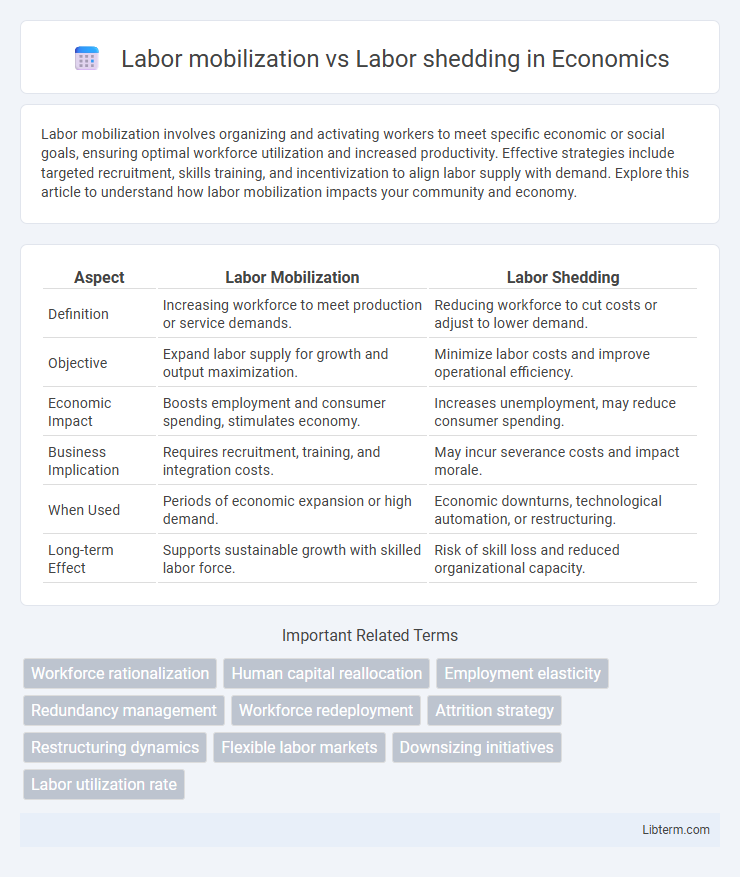Labor mobilization involves organizing and activating workers to meet specific economic or social goals, ensuring optimal workforce utilization and increased productivity. Effective strategies include targeted recruitment, skills training, and incentivization to align labor supply with demand. Explore this article to understand how labor mobilization impacts your community and economy.
Table of Comparison
| Aspect | Labor Mobilization | Labor Shedding |
|---|---|---|
| Definition | Increasing workforce to meet production or service demands. | Reducing workforce to cut costs or adjust to lower demand. |
| Objective | Expand labor supply for growth and output maximization. | Minimize labor costs and improve operational efficiency. |
| Economic Impact | Boosts employment and consumer spending, stimulates economy. | Increases unemployment, may reduce consumer spending. |
| Business Implication | Requires recruitment, training, and integration costs. | May incur severance costs and impact morale. |
| When Used | Periods of economic expansion or high demand. | Economic downturns, technological automation, or restructuring. |
| Long-term Effect | Supports sustainable growth with skilled labor force. | Risk of skill loss and reduced organizational capacity. |
Understanding Labor Mobilization and Labor Shedding
Labor mobilization involves activating and utilizing the workforce to meet organizational goals, often through recruitment, training, and redeployment to ensure optimal productivity. Labor shedding refers to the strategic reduction of employees via layoffs, attrition, or outsourcing to cut costs and adjust to market demands. Understanding labor mobilization and labor shedding is crucial for managing workforce flexibility and aligning human resources with business objectives.
Key Differences Between Labor Mobilization and Shedding
Labor mobilization involves increasing workforce deployment, often through hiring, training, or reallocating employees to meet rising production demands or new projects. Labor shedding refers to reducing the workforce by layoffs, attrition, or reassignments to cut costs or adjust to decreased demand. Key differences include their goals--mobilization aims at workforce expansion and productivity enhancement, while shedding targets cost reduction and organizational downsizing.
Economic Drivers of Labor Mobilization
Labor mobilization is primarily driven by economic factors such as expanding industries, technological advancements, and labor market demands that require increased workforce participation and skill enhancement. Labor shedding occurs as businesses adopt automation, cost-cutting measures, or respond to declining market demand, resulting in workforce reductions. Economic growth, investment in infrastructure, and government labor policies also significantly influence the patterns of labor mobilization and shedding.
Causes and Consequences of Labor Shedding
Labor shedding primarily results from economic downturns, technological advancements, and organizational restructuring aimed at cost reduction. These layoffs often lead to decreased employee morale, reduced productivity, and increased unemployment rates, affecting both individual livelihoods and broader economic stability. The long-term consequences can include skill erosion in the workforce and challenges in labor market reabsorption.
Impact on Workforce Productivity
Labor mobilization enhances workforce productivity by efficiently reallocating human resources to areas with higher demand, optimizing skills utilization, and fostering employee engagement. In contrast, labor shedding often reduces workforce capacity, leading to increased workload for remaining employees, decreased morale, and potential declines in overall productivity. Strategic labor mobilization supports sustainable growth by maintaining a balanced, adaptable workforce aligned with organizational objectives.
Social Implications of Labor Changes
Labor mobilization enhances workforce participation by creating employment opportunities and fostering skills development, which can reduce poverty and improve social cohesion. In contrast, labor shedding often leads to job losses, income instability, and increased social inequality, negatively impacting community welfare and mental health. These contrasting trends shape social structures by either empowering individuals through economic inclusion or exacerbating social exclusion and vulnerability.
Strategies for Effective Labor Mobilization
Effective labor mobilization strategies prioritize clear communication, targeted training programs, and employee engagement initiatives to maximize workforce potential and productivity. Leveraging data-driven workforce planning enables organizations to identify skill gaps and deploy labor resources efficiently, ensuring alignment with operational goals. Implementing flexible scheduling and cross-training further enhances labor adaptability, reducing the need for labor shedding during demand fluctuations.
Managing Risks Associated with Labor Shedding
Managing risks associated with labor shedding requires strategic planning to mitigate negative impacts such as decreased employee morale, loss of institutional knowledge, and potential legal repercussions. Implementing transparent communication, offering severance packages, and providing outplacement services can reduce the adverse effects on both departing and remaining workers. Organizations should conduct thorough risk assessments and comply with labor laws to ensure ethical and compliant workforce reductions.
Policy Responses to Labor Market Shifts
Policy responses to labor market shifts emphasize strategic labor mobilization through retraining programs and workforce development initiatives to align skills with emerging industry demands. Labor shedding policies often include unemployment benefits and social safety nets designed to cushion the impact of job losses during economic restructuring. Governments prioritize adaptive measures that support labor market flexibility while mitigating socio-economic disruptions caused by workforce transitions.
Future Trends in Labor Mobilization and Shedding
Future trends in labor mobilization emphasize the integration of AI-driven workforce analytics to optimize employee deployment and skill matching, enhancing productivity and agility. Conversely, labor shedding is increasingly influenced by automation and digital transformation, leading to strategic workforce reductions and reskilling initiatives to mitigate job displacement. Both trends reflect a dynamic labor market evolving under technological disruption and economic shifts, prioritizing flexible employment models and continuous workforce adaptation.
Labor mobilization Infographic

 libterm.com
libterm.com